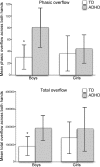Quantifying excessive mirror overflow in children with attention-deficit/hyperactivity disorder
- PMID: 21321336
- PMCID: PMC3053337
- DOI: 10.1212/WNL.0b013e31820c3052
Quantifying excessive mirror overflow in children with attention-deficit/hyperactivity disorder
Abstract
Objectives: Qualitative observations have revealed that children with attention-deficit/hyperactivity disorder (ADHD) show increased overflow movements, a motor sign thought to reflect impaired inhibitory control. The goal of this study was to develop and implement methods for quantifying excessive mirror overflow movements in children with ADHD.
Methods: Fifty right-handed children aged 8.2-13.3 years, 25 with ADHD (12 girls) and 25 typically developing (TD) control children (10 girls), performed a sequential finger-tapping task, completing both left-handed (LHFS) and right-handed finger sequencing (RHFS). Phasic overflow of the index and ring fingers was assessed in 34 children with video recording, and total overflow in 48 children was measured by calculating the total angular displacement of the index and ring fingers with electrogoniometer recordings.
Results: Phasic overflow and total overflow across both hands were greater in children with ADHD than in TD children, particularly during LHFS. Separate gender analyses revealed that boys, but not girls, with ADHD showed significantly more total phasic overflow and total overflow than did their gender-matched control children.
Conclusions: The quantitative overflow measures used in this study support past qualitative findings that motor overflow persists to a greater degree in children with ADHD than in age-matched TD peers. The quantitative findings further suggest that persistence of mirror overflow is more prominent during task execution of the nondominant hand and reveal gender-based differences in developmental neural systems critical to motor control. These quantitative measures will assist future physiologic investigation of the brain basis of motor control in ADHD.
Figures



Comment in
-
Faulty brakes? Inhibitory processes in attention-deficit/hyperactivity disorder.Neurology. 2011 Feb 15;76(7):592-3. doi: 10.1212/WNL.0b013e31820c30f3. Neurology. 2011. PMID: 21321332 No abstract available.
Similar articles
-
Atypical motor and sensory cortex activation in attention-deficit/hyperactivity disorder: a functional magnetic resonance imaging study of simple sequential finger tapping.Biol Psychiatry. 2006 Jan 1;59(1):48-56. doi: 10.1016/j.biopsych.2005.06.011. Epub 2005 Sep 1. Biol Psychiatry. 2006. PMID: 16139806
-
Sex Effects on Mirror Overflow during Finger Tapping in Children with ADHD.J Int Neuropsychol Soc. 2022 Apr;28(4):371-381. doi: 10.1017/S1355617721000576. Epub 2021 May 17. J Int Neuropsychol Soc. 2022. PMID: 33998435 Free PMC article.
-
Altered cortical activation associated with mirror overflow driven by non-dominant hand movement in attention-deficit/hyperactivity disorder.Prog Neuropsychopharmacol Biol Psychiatry. 2022 Jan 10;112:110433. doi: 10.1016/j.pnpbp.2021.110433. Epub 2021 Aug 27. Prog Neuropsychopharmacol Biol Psychiatry. 2022. PMID: 34454990 Free PMC article.
-
Overflow movements and white matter abnormalities in ADHD.Prog Neuropsychopharmacol Biol Psychiatry. 2010 Apr 16;34(3):441-5. doi: 10.1016/j.pnpbp.2010.01.013. Epub 2010 Jan 25. Prog Neuropsychopharmacol Biol Psychiatry. 2010. PMID: 20100533 Review.
-
[Transcranial magnetic stimulation (TMS), inhibition processes and attention deficit/hyperactivity disorder (ADHD) - an overview].Z Kinder Jugendpsychiatr Psychother. 2014 Nov;42(6):415-28; quiz 428-9. doi: 10.1024/1422-4917/a000320. Z Kinder Jugendpsychiatr Psychother. 2014. PMID: 25335520 Review. German.
Cited by
-
Attention-deficit/hyperactivity disorder and adverse health outcomes.Clin Psychol Rev. 2013 Mar;33(2):215-28. doi: 10.1016/j.cpr.2012.11.005. Epub 2012 Dec 7. Clin Psychol Rev. 2013. PMID: 23298633 Free PMC article. Review.
-
Memory-guided force output is associated with self-reported ADHD symptoms in young adults.Exp Brain Res. 2016 Nov;234(11):3203-3212. doi: 10.1007/s00221-016-4718-1. Epub 2016 Jul 9. Exp Brain Res. 2016. PMID: 27394915 Free PMC article.
-
Reduced homotopic interhemispheric connectivity in psychiatric disorders: evidence for both transdiagnostic and disorder specific features.Psychoradiology. 2022 Nov 24;2(4):129-145. doi: 10.1093/psyrad/kkac016. eCollection 2022 Dec. Psychoradiology. 2022. PMID: 38665271 Free PMC article. Review.
-
Neurological Soft Signs at Presentation in Patients With Pediatric Acute-Onset Neuropsychiatric Syndrome.JAMA Netw Open. 2025 Mar 3;8(3):e250314. doi: 10.1001/jamanetworkopen.2025.0314. JAMA Netw Open. 2025. PMID: 40053347 Free PMC article.
-
Automated diagnoses of attention deficit hyperactive disorder using magnetic resonance imaging.Front Syst Neurosci. 2012 Aug 30;6:61. doi: 10.3389/fnsys.2012.00061. eCollection 2012. Front Syst Neurosci. 2012. PMID: 22969709 Free PMC article.
References
-
- Denckla MB, Rudel RG. Anomalies of motor development in hyperactive boys. Ann Neurol 1978;3:231–233 - PubMed
-
- Szatmari P, Taylor DC. Overflow movements and behavior problems: scoring and using a modification of Fogs' test. Dev Med Child Neurol 1984;26:297–310 - PubMed
-
- Mostofsky SH, Newschaffer CJ, Denckla MB. Overflow movements predict impaired response inhibition in children with ADHD. Percept Mot Skills 2003;97:1315–1331 - PubMed
-
- Armatas CA, Summers JJ, Bradshaw JL. Mirror movements in normal adult subjects. J Clin Exp Neuropsychol 1994;16:405–413 - PubMed
-
- Mayston MJ, Harrison LM, Stephens JA. A neurophysiological study of mirror movements in adults and children. Ann Neurol 1999;45:583–594 - PubMed
Publication types
MeSH terms
Grants and funding
LinkOut - more resources
Full Text Sources
Medical
Miscellaneous
